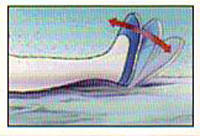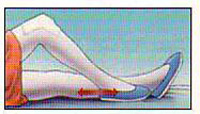The knee is a complex joint. It is required to flex and extend (like a hinge), rotate, slide forward and back and side to side. It is the largest and most complex of the human joints.
Total Knee Replacement has evolved from humble beginnings in the 1960’s to a precise and reproducible procedure using tried and tested surgical techniques and state of the art instrumentation to ensure enhancement of your lifestyle by relief of pain and restoration of normal joint function.
The bones of the knee, when healthy, are covered with articular cartilage. Shock absorption is provided by the menisci, and ligaments provide the stability. As the knee degenerates the articular cartilage wears away, the menisci may tear and the ligaments rupture or become unstable. This leads to pain, instability and lack of function.
Exercises for the Knee Regular exercises to restore knee motion and strength, and a gradual return to everyday activities are important for your full recovery.

Ankle Pumps
Slowly push your foot up and down. This exercise can be done several times a day.

Bed Supported Knee Bends
Slide your heel toward your buttocks, bending your knee and keeping your heel on the bed. Do not let your knee roll inward.

Straight Leg Raises
Tighten your thigh muscle with your knee fully straightened on the bed. As your thigh muscle tightens, lift your leg several inches off the bed, hold then slowly lower.

Sitting Unsupported Knee Bends
Whilst sitting with your thigh supported, place your non operated foot behind the foot of the operated knee side for support, bend your knee as far as you can ‘till your foot rests on the floor, then slowly raise it again.

Standing Knee Bends
Standing erect with the aid of a walker or crutches, lift your thigh and bend your knee as much as you can, then straighten.

Sitting Supported Knee Bends
Whilst sitting with your thigh supported, place your non-operated foot behind the foot of the operated knee side for support. Bend your knee as far as you can until your foot rests on the floor, then slowly raise it again.

Stair Climbing
The ability to go up and down stairs requires strength and flexibility. At first you will require the use of a handrail for support.
- Always lead up the stairs with your good knee and down the stairs with your operated knee.
- Remember “up with the good” and “down with the bad”.

Walking
Proper walking is the best way to help your knee recover. At first, you will use a walker or crutches. Your surgeon or physiotherapist will advise you how much weight to put on your leg.
